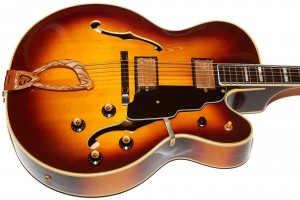
Being a gear hound, the chance for a second X-500 of similar vintage (1986) was too good to pass up so I ended up with two of these big ‘ol Guilds and thought, “Why not write about them?” and here we are.
These guitar were a bit of a challenge for me to write about because their proper use is a bit outside of my comfort zone. They are guitars, however, and me being me, I was not afraid to sit down and run them through their paces in order to write up what I could about the instruments. Let’s dig in and see how they fared.
Introduction
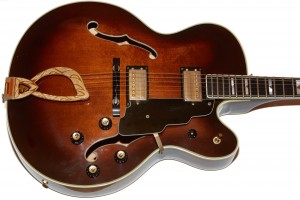
High-end jazz guitars like Guilds Artist Award models have no electronics or controls cut into the top in order to maximize the instrument’s sound because the sound is generated by the top. They also have carved solid tops and cost a lot of money because they are usually hand-crafted instruments built for jazz.
A step below those boxes are the high-end jazz boxes that look similar to the X-500, but come with solid carved tops, Guild’s version being the X-700. The X-500 is similar to the X-700, but comes with a laminated top which cuts the price down a great deal. Based on this naming system one could argue that the X-500 is the third from the top of the line in Guild’s electric guitar line, though the Artist Award is really an acoustic instrument that happens to have a pickup on it.
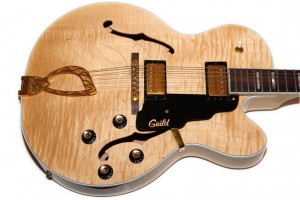
Of course, I haven’t even included other arch-tops like the X-180, X-185, A-150, and who knows what else. As usual, if you’d like to learn more about Guild models and the company’s history, I encourage you to get a copy of The Guild Guitar Book by Hans Moust.
Finish
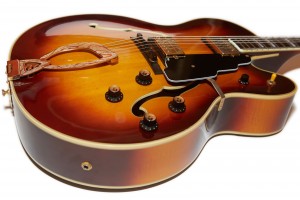
For the remainder of this article I will refer to the colors of these guitars as cherry-burst and walnut in order to spare you from the grammatical gymnastics that would be otherwise necessary to differentiate them in print.
Fretboard and Neck
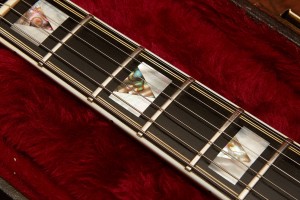
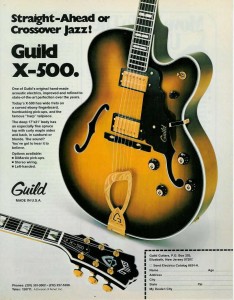
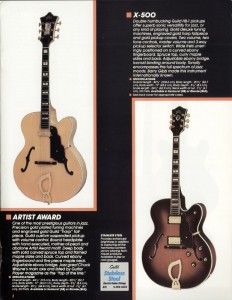
The neck on the walnut X-500 is perfectly straight and shows no sign of needing any work, whatsoever. I attribute the very straight necks on Guilds like this to the multiple wood-types used to make the necks which is usually shown as a stripe down the back of the neck. This guitar has a triple stripe as the neck is actually a five-piece neck. The neck on the 1986 X-500 I have isn’t quite so perfect, and though the details have nothing to do with the build-quality of the guitar, they are worth covering for the curious and to serve as a permanent record should I ever decide to sell it.
The cherry-burst X-500 has some issues that I knew about when I bought it, taking the chance that the problems were not as bad as they appeared. The issue is a crack along the heal that separates the neck heel cap from the binding on the guitar body. When I first looked at this, I was convinced that neck had separated from the body, probably as a result of major impact, and that it would require a complete reset.
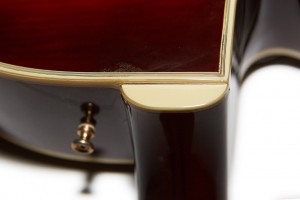
Build Quality
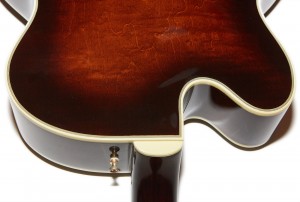
There is really only one complaint I have with the build quality, if that’s even the proper category for this discussions, and that is the relatively thin gold plating on everything thats plated. This is most notable on the pickups, which will be covered in detail in the next section, but every gold-plated surface on the walnut X-500 guitar is significantly worn.The cherry-burst is in great shape, but I don’t think it was played much.
To be fair, many guitarist dislike gold hardware specifically because it wears with use and tends to look bad over time, but Guilds are notorious for seemingly having an even thinner gold plating than other brands. I have no idea if that’s true or not, and since this is electroplating we’re talking thicknesses in the realms of micro-inches (1/1,000,000 inch) and microns (1/1,000 millimeter), thicker can mean the difference between .762 microns (class-0 plating) and 1.25 microns (class-1 plating). Since gold is so soft, it’s easy to wear down such a thin layer over time.
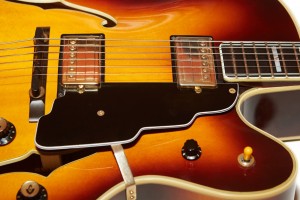
To be perfectly fair, all of those parts function perfectly and there is no impact to the playability or function of the guitar, so many people will chide those of us that like new-looking instruments with the ultimate implied insult, “but how do they sound?” Spoiler: They sound great.
Pickups
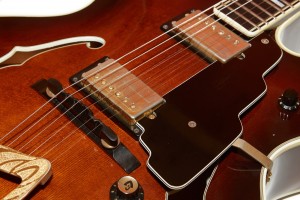
When I first got the walnut X-500, I pulled the old strings off, cleaned it up, polished the frets, and put on a set of Ernie Ball Regular Slinky (10s) round-wound strings. Those strings are not what this guitar was made for, and the guitar let me know in the form of sub-par tone and enhanced finger noise.
I went to Guitar Center and bought a set of medium-gauge (13s) flat-wound strings to see how they would work. I’m not a fan of flat-wounds for various reasons, but that’s often what gets put on a guitar like this so I tried them. They sounded terrible. Yeah, i know, I said above that they sound great. Read on.
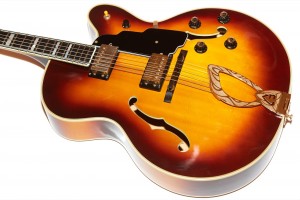
HB-1s are great because they’re clear and crisp with a bit of upper-end response that isn’t present in most other humbuckers, but this is a big boomy jazz box so their upper-end character is easily lost, especially if you’re fond of rolling the tone back as some people like to do on these guitars. With the pickups dialed in, the guitar finally sounded great.
One of the cool things about these guitars is that they’ll do that treble rolled off jazz type of sound, but with the bridge pickup on and those killer HB-1s in place, these guitars will rock, too. I wouldn’t use one for playing Crazy Train in an ’80s tribute band, but some Ted Nugent? Why not? He did use a ’62 Gibson Byrdland, after all, though that would be more like Guild’s X170 than one of these big-box X-500s.
Electronics
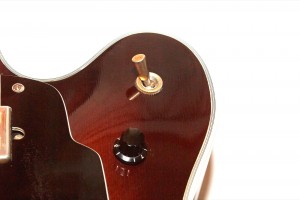
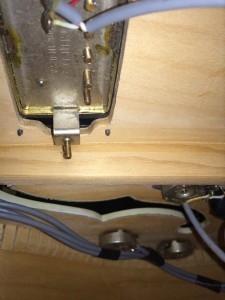
As a quick aside, if you zoom into the pic you can see the cutout for the pickup in detail which shows the laminate layers in the top. You gotta pay X-700 money to get the carved top version of a guitar like this.
Sorry the picture isn’t any better. I could only shove my iPhone 5s so far into the f-hole without risk of it falling in there. Suffice to say that was a problem I was not eager to solve and you should all be ashamed for giggling at the unintentional double entendre.
Hardware
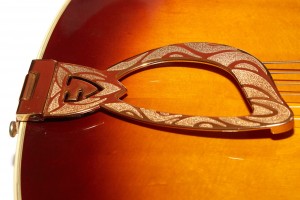
The tuners on the walnut 1984 X-500 are Guild emblazoned Gotohs tuners which are one of my favorites (along with Schallers), so I’m a happy guy in that department, though the tuner buttons have much of the gold worn off along with other well-rubbed metal parts of the guitar. The tuners on the cherry burst 1986 X-500 are grovers.
On nicer Guild archtops, an engraved gold harp piece is included. I love the iconic Guild harp tailpieces, and the gold ones just take it to a whole new level. The example on the cherry burst X-500 shows the beautiful detail of the harp and displays very little if any wear.
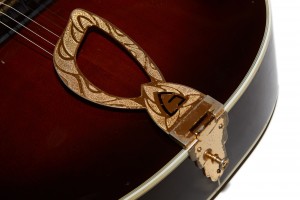
I’m not sure how wear like this happens, but my suspicion is that the mounting part of the assembly is made from different material than the harp itself, and the mounting bracket is more prone to wear. Perhaps it worn because of strap friction since the strap peg is right there.
While the hinge and mounting plate look pretty terrible, the piece that people see when you play looks damn-near brand new, and if I had to pick one or the other to be worn, the I’d pick the one that is. Honestly, I didn’t even notice the wear on the end of this guitar until I set it down to take these pictures. I mean, how often do you look at the bottom end of your guitars?
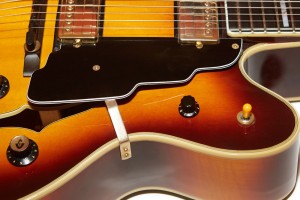
Guild fixed this in the late 1990s when they reintroduced many of their iconic models, and on my my late ’90s and early ’00 Guilds the pick guard is much improved.
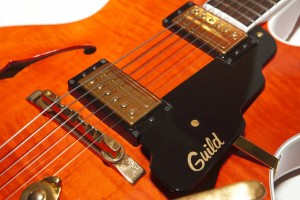
Sound
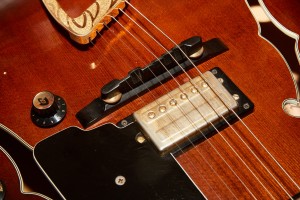
With its deep hollow body, ebony bridge, harp tailpiece, and properly adjusted pickups, the guitar has a very woody sound that none of my other guitars can attain. Note that those these two guitars are X-500s and are only two years apart (1984 and 1986), they actually behave a bit differently from one another.
The reason they behave differently is that the 1984 walnut X-500 is a true hollow-body with only a couple of small sound posts inside the body likely to maintain structural stability in the big guitar. The 1986 cherry burst X-500 had a big ‘ol honkin’ sound block right under the bridge in addition to the other smaller posts.
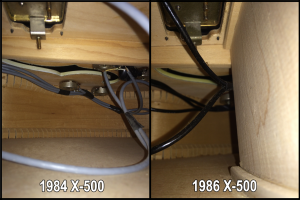
While the sound block benefits the guitar by reducing feedback, it also deadens the guitar acoustically which is a real shame for a guitar that is ostensibly designed for jazz. Indeed, the 1984 walnut X-500 without the sound block under the bridge is a much livelier instrument that feels more like an acoustic guitar because it is much louder when played acoustically. The 1986 cherry burst X-500 with the sound block feels a bit “deader” in my hands. I would describe the feeling of playing the 1986 X-500 as being very similar to the way a Guild Starfire IV feels when played unplugged. In short, you feel like you want to plug it in, which is not the case with the true hollow body without the sound block. Whether or not this difference is audible through an amp on stage with a band is debatable, but the purist in me says that a guitar was advertised and sold as a jazz box, and thus should not have the block, though I suppose the use of the term “crossover jazz” in the ad give them a certain amount of leeway.
For the sound recordings I put the same strings on both guitars in the hopes that any differences in the character of the guitars themselves might come through. The stings in use are D’Addario XL Chrome flat-wounds 12-52 strings. I chose these strings because they were the only flat-wound strings I could find at any music store in a 20 mile radius, and even then they were the last two packs. I did buy a couple of sets Thomastik-Infeld JS112 jazz guitar strings on Amazon only to discover that the silk-wound ball ends of the strings would not seat into the harp tailpiece so I had to abandon those unless I wanted to alter the beautiful harp tailpiece.
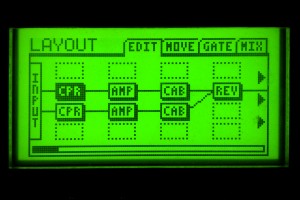
1984 X-500 Acoustic
1986 X-500 Acoustic
1984 X-500 Chords
1986 X-500 Chords
1984 X-500 Lick
1986 X-500 Lick
1984 X-500 Finger
1986 X-500 Finger
Again, I detect a bit more tightness in the bottom end of the 1986 X-500 with its sound block. I could have likely backed off the boominess of both of them by removing the speaker from the floor but that seemed an awful lot like real work so I elected to pass.
Playability
As you may know from reading my other Guild reviews, I prefer larger necks on guitars. While the 1984 walnut guitar does have a more narrow 1 5/8″ neck at the nut, the depth of the neck is a bit deeper than most of the 1970s Guilds I’ve played which makes the overall playing experience much nicer than it is on those pencil-necked mid-’70s Starfire guitars, at least for this guy with his freakishly long fingers.
These are big guitars. If you’ve never played one of these big jazz boxes, they’re basically about the size of a dreadnaught or jumbo acoustic, but heavier depending on the materials involved. They feel like heavy guitars, but weighing in at 8 lbs 7 oz, the 1984 X-500 lighter than many of my solid body guitars. The 1986 X-500 weighs 9 lbs 2 oz, and I imagine the difference of 2/3 of a pound is as a result of that sound post which is a big solid block of maple.
I think part of the reason these seem so heavy is due to the fact that it looks and feels like an acoustic, but most acoustics don’t weigh nine pounds. The fact remains that these are very big guitars with a relatively small necks, the combination of which is a little weird for me, but it’s easy to forget about all of that once I start playing because they both sound so damn good plugged in.
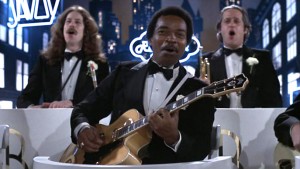
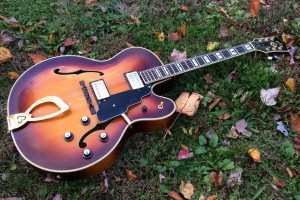
The playability of this style of guitar also changes pretty significantly depending on what type of strings you favor. Being a long-time rock player, I tend to like round-wound strings, but many players prefer flat-wounds on jazz boxes because that finger-sliding sound is considered obnoxious in jazz, and having tried them on both of my X-500s, I think the big guitar body further amplifies that terrible sound. The problem with flat-wound strings is that they sound a bit darker than round-wounds, and for rock players who often chase brightness to the extreme, that can seem counter-intuitive. Jazz players don’t look for brightness, and in fact prefer the tone rolled off a bit (or a lot), especially when comping chords. To compromise a lot of users will use semi-round strings which add a touch of brightness yet also reduce string noise.
Conclusion
The Guild X-500 is an upscale instrument that is built from the ground up for jazz. It’s big, it’s fully hollow, it has an ebony bridge, and will deliver all the beautiful tonal complexities of such a guitar with graceful aplomb, provided that it’s set up properly for the strings of your choice.
Make no mistake, these are expensive guitars. I usually see these selling on the used market for over $2000, and often much more than that depending on the level of departure from reality embraced by the seller. Are they worth it? That really depends on the condition of the instrument in question. Having owned two of them, I would be willing to pay for one that was exactly what I wanted with a wider fretboard, original HB-1 pickups, and no sound block under the bridge. Sadly, from what I can tell, that combination only exists in the much more expensive X-700.
When Guild was owned by Fender, these X-500s were being made but they were shipped with the Fender HB-1 pickups which I generally dislike, but if your style is more jazz than rock, those pickups may work for you. Don’t discount these early 2000-era X-500s because they are still very well-made instruments that often show up in mint condition because they’re only 10 years old or so. I don’t know if those ’00-era X-500s have an under-bridge sound block, but my suspicion is that they do so if that’s important to you, make sure to ask before you buy.
Also, X-500s (like most Guild electrics) after about 1990 or so started coming with 1 11/16″ necks. As much as I like these guitars, having one with a wider neck would be a priority for me. So much so, in fact, that I may sell off both of these and search for a pre-1995 X-500 or even an X-700.
Therein lies the problem with these guitars: they’re fantastic. If the X-500 is so great, it really makes me wonder how amazing an X-700 must be. As you probably know, GAS is the colloquial acronym for Guitar Acquisition Syndrome. It is a disease, and guitars like these are the fuel that feeds the flame of perceived gear inadequacy.
I know a couple of guys that have a collection of Guild X-500s, and after owning these for a while and playing it extensively, I can see why. Are they the same as the coveted Guild Artist Award? No, but they don’t pretend to be. They’re not $8,000, either. Should you buy one? Only you can decide that. These aren’t $650 1981 Guild M-80s that you might buy on a whim but rather serious, expensive, high-end instruments that you buy for $2000 on a whim. You know, because GAS.
Donate: PayPal Crypto:
ETH: 0x0AC57f8e0A49dc06Ed4f7926d169342ec4FCd461
Doge: DFWpLqMr6QF67t4wRzvTtNd8UDwjGTQBGs

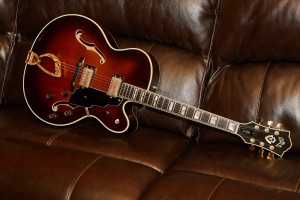
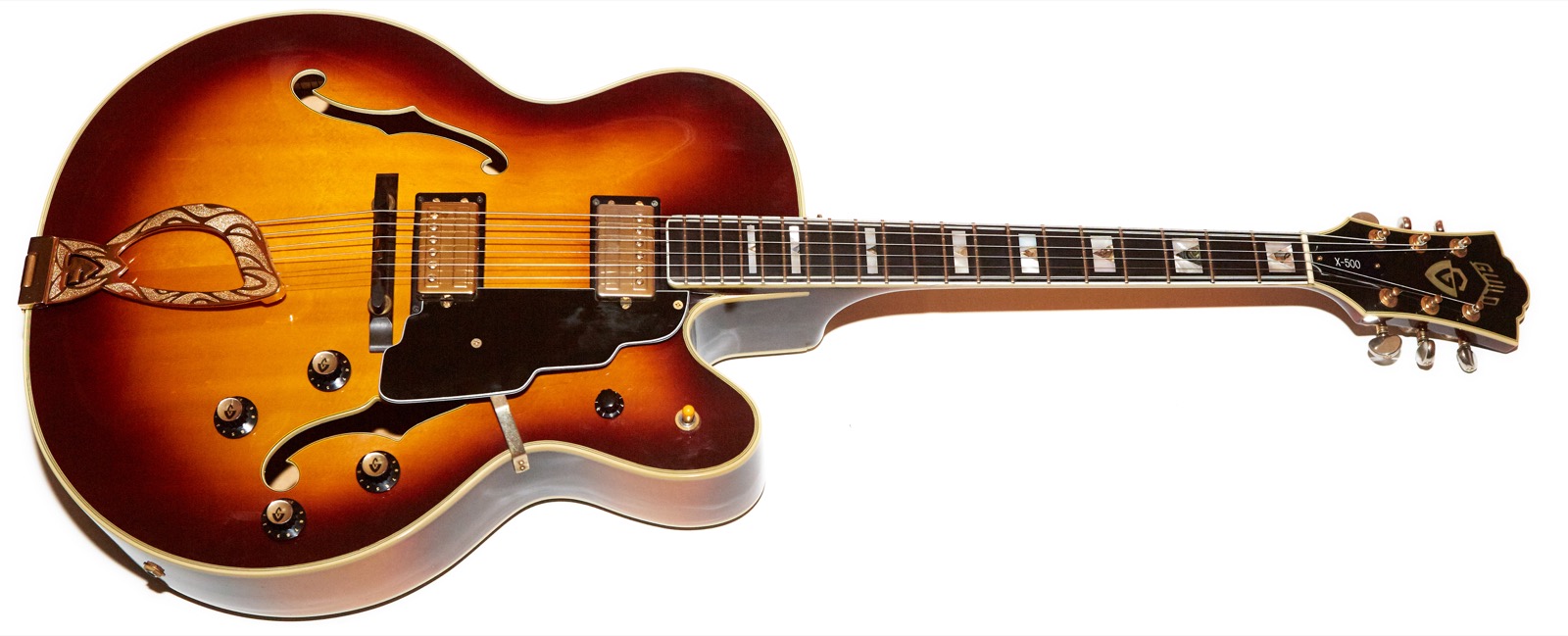
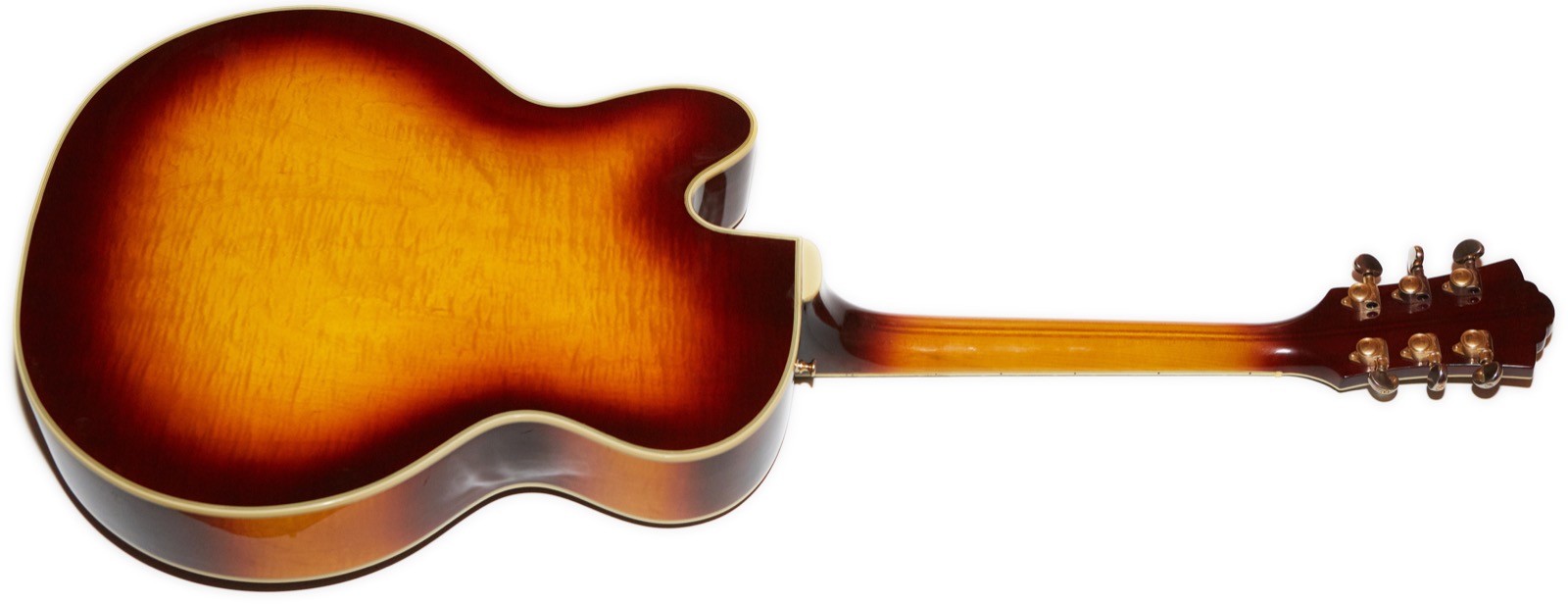
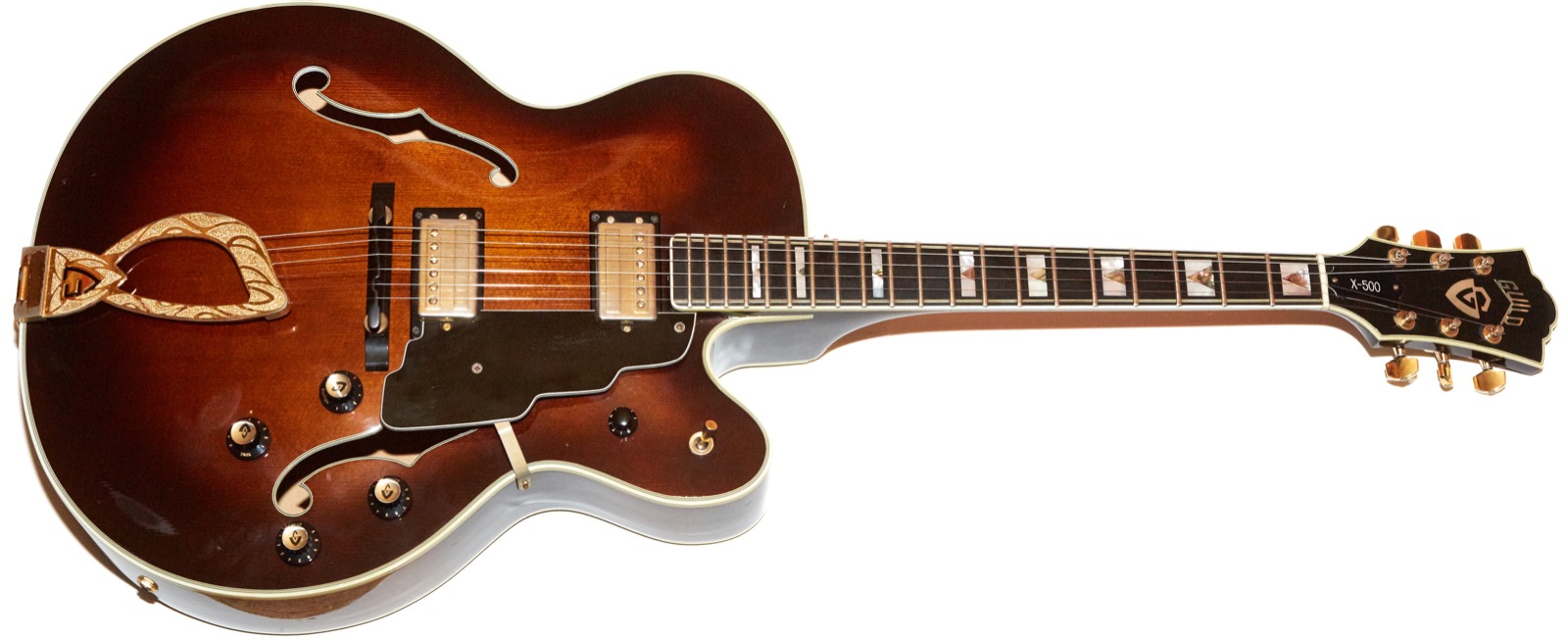
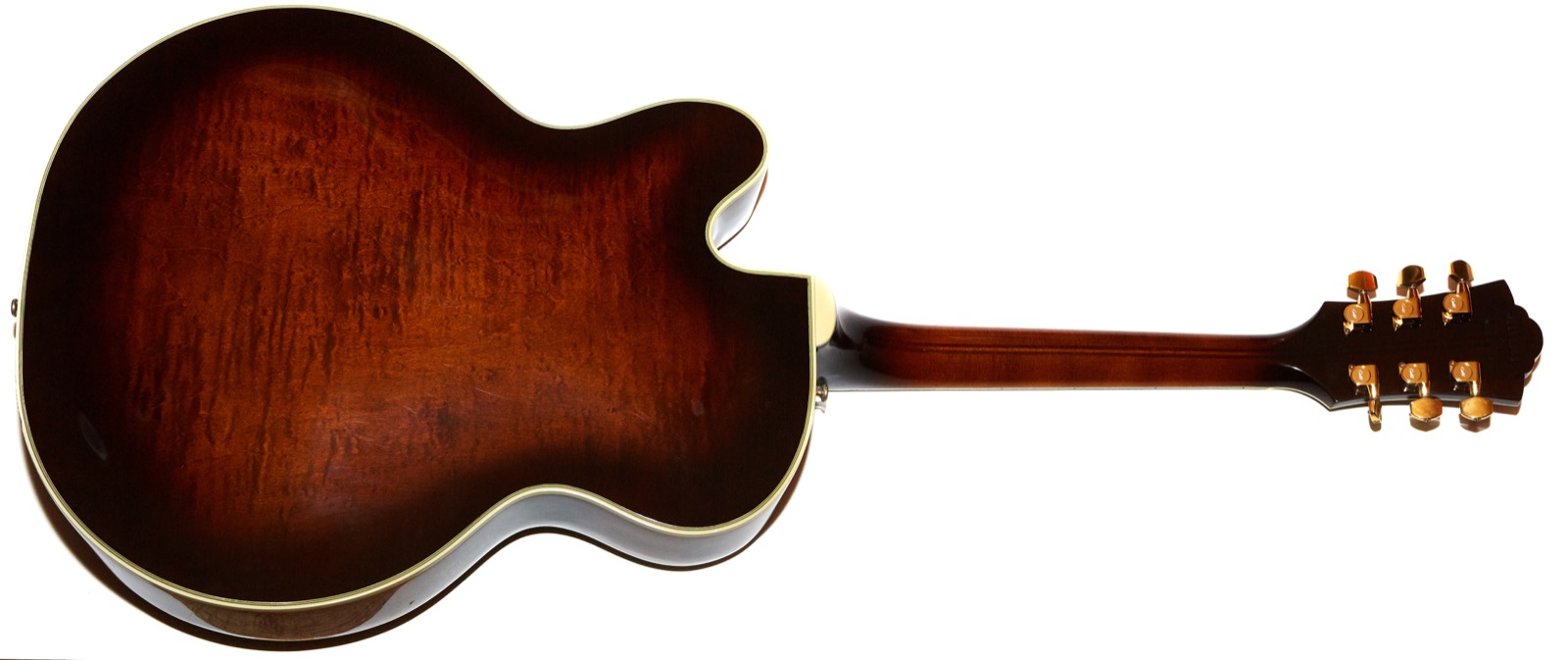
Thanks for the nice article and honesty.
Did you buy any chance buy the Walnut X500 around 2012 ish from Stow Massachusetts?
Also do you still have the Walnut X500?
Thanks Jerry
I bought the Walnut X500 in 2016. I don’t remember from where. It has since been sold.
GAD, I love Guilds as well. It’s funny at the end of your article you mentioned the M-80. That was my 1st new guitar I ever bought 1983. I own a X-170 as well, as you mentioned and I did change out the rosewood bridge. I own 6 Guilds and I prefer the smaller necks as I don’t have real long fingers. I think I will be down sizing as to upgrade.
Hi GAD, big fan of your reviews, thanks for your time! I’m trying to decide between a 1988 X-500 and GSR X-180 with Guildsby, -only 5 were made! Prices are almost the same. As I understand both have deep bodies, GSR X-180 doesn’t have a sound block and has spruce top (solid?), no bound f-holes and ebony fretboard on the GSR 180 etc. but overall an impressive custom shop limited edition. Seymour Duncon pick-ups vs. HB1. I tend to the GSR honestly, but is there any reason to prefer the 1988 X-500 as a jazz guitar? The Guildbsy is a plus to me, as I don’t only play jazz. And the wood, craftsmanship, hardware looks flawless on the GSR X180… And probably I will never have the chance to pick up a GSR X180 in my hometown. 🙂 What do you think? Cheers!
I’ve handled a couple of GSRs and they were exemplary guitars with the only exception being the GSR M75 Aristocrat. The ’88 X500 will have a more vintage feel to it since it’s, well, more vintage, but I seriously doubt you would be disappointed in a GSR X180. The X500 will get you more bling and nicer appointments, and of course the HB1s are all that and more, but given that there are more X500s in the world, you could always get one later if somehow the X180 didn’t work for you. I don’t recall the specs, but the X180 probably has a 1 11/16″ neck at the nut while the ’88 X500 will be 1 5/8″, so that’s something to consider as well.
Really, though, think about your predicament: deciding between two killer Guilds. You can’t lose! 🙂
Thx for the review. Perfedt job…
I could use some expert advice Please. I recently bought a 2003 Guild x-500 but when i play it without electric
it has some kind of distortion/vibration or rattling noise. Not that anything is loose or the strings buzzing on the frets, it’s something else. Any help is appreciated
It could be the wiring inside. The wiring is tied down with either electrical tape, zip ties that stick to the inside, or both. If someone worked on it and didn’t properly secure the wires or of the glue has failed over time, this can lead to rattling.
It could also be a broken spring under the pickup adjustment screws.
Other things are possible, but I’d start there.
Hi Gary, thanks for all the great information about the Guild’s and especially the X-500’s. I’ve been looking for a fair X-500 now for more then 10 years and finally found one for sale here in the Netherlands. I got some doubts thow about this guitar and hope it isn’t fake. It’s a white X-500DE, Duane Eddy Prototype. From the serialnumber it seems that it’s build in 1987. There are a couple things thow that are a little strange about this guitar and I’ve asked support/information at the forum ‘Lets talk Guild’. They told me to get in contact with the dutch Guild expert Hans Moust. Unfortunally I don’t get any response from Hans so I contacted the Guild Company (Cordoba Music Group) and their expert Noah Winner told me I should take a look at your website and try to get in contact with you. I’ve been reading all the information about the X-500’s on your website and it’s fantastic how many information and details you’re teaching us! I haven’t found anything about the X-500DE or Duane Eddy prototypes. Did you ever heard about these prototypes?
I saw the thread on LTG (which I also run) about the guitar. I don’t have a better answer than what’s already been posted there, but I have my doubts that it’s a DE prototype. Unfortunately Hans is the only one who can answer that, but for what it’s worth I’ve never seen a DE with humbuckers. Guild did reissue a DE model in the ’80s and it looks nothing like that. According to the SN charts it’s an X500 from ’88 and the finish looks like it could be original. I’ve never seen an X500 or a DE in white, but custom guitars were certainly a thing. That guitar has a lot of red flags as outlined on LTG so if considering it I wouldn’t pay any more than I would for a regular X500. I find it kind of hard to believe that Guild would have used a non-Guild Bigsby on a guitar in the ’80s, too.
Have you tried sending a private message (conversation) to Hans on LTG? He’s there quite often.